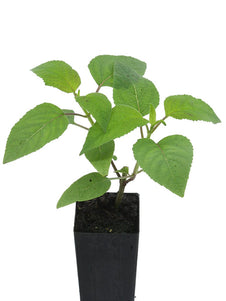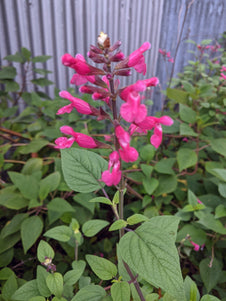







Salvia involucrata 'Joan'
Salvia involucrata 'Joan'

- Low stock - 3 items left
- Inventory on the way

Usually available: All year
Life cycle: Perennial
Height: 1 - 1.5m
Position: Sun / part shade
Soil preference: Well drained
This is how we pack and send your Herb Plants to all states except TAS & WA
You will receive
- 1 Salvia Joan Herb Plant in a 50 X 75mm tube - General growing instructions
All of our Herb Plants are grown organically with certified organic potting mixes and fertilizers
Botanical Name: Salvia involucrata Joan
Salvia Joan is a pretty plant with cerise pink flowers, growing up to 1.5 tall and equally wide. The leaves are dark green, ovate and have noticeable veins. The flowers are bright with a wide lip and a darker purple calyx to set off the colour. The plant flowers over a long period from summer to winter and then again from late autumn into the summer flowering period.
This salvia is related to an old garden favourite Salvia involucrata ‘Bethellii’, which was first cultivated in 1881. The parent of Salvia Joan is S. involucrata - Roseleaf Sage which is found growing naturally in Mexico in shady places, near the edge of forests. The ‘involucrata’ terminology refers to the prominent, large and colourful flower bracts. Salvia Joan is said to have better foliage and colour than the old Bethel Salvia which was once a common garden plant.
Salvia has a long tradition of medicinal use, especially in the regions where the various species grow naturally. Salvia involucrata has a history of use as a memory enhancer in the regions of Mexico where it is originally found. This salvia and other species contain compounds that affect the cerebral cortex and have the ability to bind to acetylcholine. For further information on the medicinal uses of Salvia please see Salvia officinallis or Common Sage.
Growing Conditions
Salvia Joan is suitable for hot and humid areas, prefers deep watering and seems to tolerate some wetness in the soil. However, good drainage in an enriched soil is preferred for better plant health. It seems to tolerate dryness as well, but a deep watering at least once a week is recommended. This generally hardy saliva is also quite tolerant of frost and can even flower in winter if it is mild weather. Where there is heavy frost the plant will die down and return in spring. A full sun or part shade position is suitable.
Salvia involucrata varieties form good clumps and can spread up to 1.2 meters, creating an informal hedge if several are planted. The plant can be pruned or extra width removed by digging out the roots and stems on the outside of the plant. To maintain plant health it can be pruned back after flowering to the new nodes visible at the base of the plant. Propagation is by root division or by cuttings.
The salvia family has over 900 members with an extensive history as culinary, medicinal and ornamental plants. Ornamental salvias have become collectors’ items, as gardeners try to find a place in their garden for each and every one. There are salvias that will suit every type of soil and climate. More information on the Salvia genus and Common Sage (Salvia officinalis) may be found on our Common Sage page.
All information provided on this website is for informational purposes only. Please seek professional advice before commencing any treatment.





